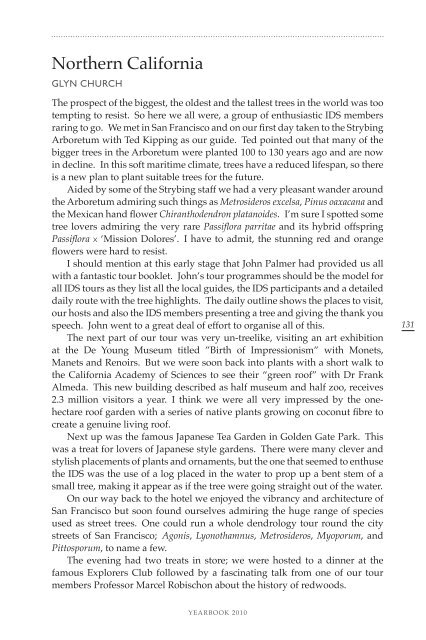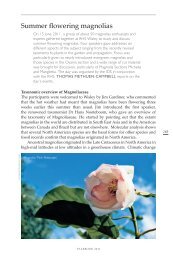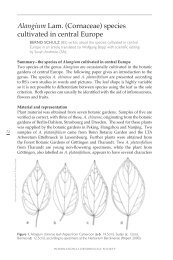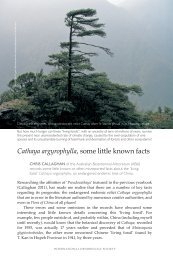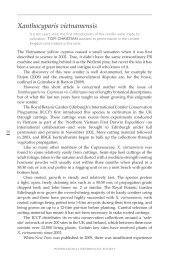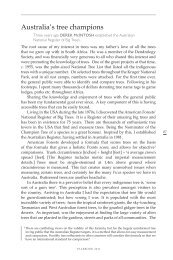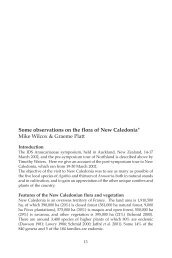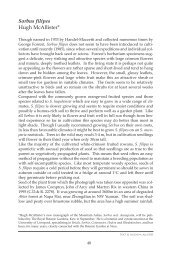Northern California - International Dendrology Society (IDS)
Northern California - International Dendrology Society (IDS)
Northern California - International Dendrology Society (IDS)
You also want an ePaper? Increase the reach of your titles
YUMPU automatically turns print PDFs into web optimized ePapers that Google loves.
<strong>Northern</strong> <strong>California</strong><br />
GLYN CHURCH<br />
The prospect of the biggest, the oldest and the tallest trees in the world was too<br />
tempting to resist. So here we all were, a group of enthusiastic <strong>IDS</strong> members<br />
raring to go. We met in San Francisco and on our first day taken to the Strybing<br />
Arboretum with Ted Kipping as our guide. Ted pointed out that many of the<br />
bigger trees in the Arboretum were planted 100 to 130 years ago and are now<br />
in decline. In this soft maritime climate, trees have a reduced lifespan, so there<br />
is a new plan to plant suitable trees for the future.<br />
Aided by some of the Strybing staff we had a very pleasant wander around<br />
the Arboretum admiring such things as Metrosideros excelsa, Pinus oaxacana and<br />
the Mexican hand flower Chiranthodendron platanoides. I’m sure I spotted some<br />
tree lovers admiring the very rare Passiflora parritae and its hybrid offspring<br />
Passiflora x ‘Mission Dolores’. I have to admit, the stunning red and orange<br />
flowers were hard to resist.<br />
I should mention at this early stage that John Palmer had provided us all<br />
with a fantastic tour booklet. John’s tour programmes should be the model for<br />
all <strong>IDS</strong> tours as they list all the local guides, the <strong>IDS</strong> participants and a detailed<br />
daily route with the tree highlights. The daily outline shows the places to visit,<br />
our hosts and also the <strong>IDS</strong> members presenting a tree and giving the thank you<br />
speech. John went to a great deal of effort to organise all of this.<br />
The next part of our tour was very un-treelike, visiting an art exhibition<br />
at the De Young Museum titled ”Birth of Impressionism” with Monets,<br />
Manets and Renoirs. But we were soon back into plants with a short walk to<br />
the <strong>California</strong> Academy of Sciences to see their “green roof” with Dr Frank<br />
Almeda. This new building described as half museum and half zoo, receives<br />
2.3 million visitors a year. I think we were all very impressed by the onehectare<br />
roof garden with a series of native plants growing on coconut fibre to<br />
create a genuine living roof.<br />
Next up was the famous Japanese Tea Garden in Golden Gate Park. This<br />
was a treat for lovers of Japanese style gardens. There were many clever and<br />
stylish placements of plants and ornaments, but the one that seemed to enthuse<br />
the <strong>IDS</strong> was the use of a log placed in the water to prop up a bent stem of a<br />
small tree, making it appear as if the tree were going straight out of the water.<br />
On our way back to the hotel we enjoyed the vibrancy and architecture of<br />
San Francisco but soon found ourselves admiring the huge range of species<br />
used as street trees. One could run a whole dendrology tour round the city<br />
streets of San Francisco; Agonis, Lyonothamnus, Metrosideros, Myoporum, and<br />
Pittosporum, to name a few.<br />
The evening had two treats in store; we were hosted to a dinner at the<br />
famous Explorers Club followed by a fascinating talk from one of our tour<br />
members Professor Marcel Robischon about the history of redwoods.<br />
YEARBOOK 2010<br />
131
132<br />
photograph © Philippe de Spoelberch<br />
NORTHERN CALIFORNIA<br />
Above, a stand of Calocedrus decurrens at Ahwahnee, in Yosemite National Park.<br />
Opposite, Abies concolor var. lowiana at Crags in Mount Lassen Volcanic National Park.<br />
Day 2 Lest we leave someone behind, it was prudent to count the troops,<br />
and Arabella bravely took on the role for the duration and was dubbed the<br />
“Countess”. Leaving the city and heading north across the Golden Gate<br />
Bridge towards the Sonoma Valley, we were like a bunch of excited school kids<br />
on a days outing. Our first stop was Casa Bowes, an iconic <strong>California</strong>n house<br />
with bright orange walls contrasting with the never-ending blue sky.<br />
The house has a genuine indoor outdoor feel, with beautiful modern art<br />
on the inside and a stylish garden designed by Roger Warner on the outside,<br />
including an avenue of ancient Olea europaea specially moved onto the<br />
site. Several of the exterior walls were decorated with flowering climbers such<br />
as bright purple Bougainvillea and the scented Trachelospermum jasminoides. We<br />
were all impressed by the borders of drought resistant herbaceous plants, so<br />
fitting but also essential in this climate.<br />
We made a short visit to the Quarryhill Botanical Garden for a picnic<br />
lunch and a presentation planting of an Acer pentaphyllum. The Director, Bill<br />
McNamara has travelled to China to collect seed of this very rare maple and<br />
planted a grove of them to help preserve the species from extinction and to<br />
create a new seed source. Up until recently all of the plants of Acer pentaphyllum<br />
in cultivation came from one plant in the Strybing Arboretum collected by<br />
Joseph Rock in China in 1929. Thankfully it grows easily from cuttings and this<br />
has allowed the Rock version to spread around the globe.<br />
In the afternoon we were given a private tour of the Benziger Winery<br />
by the owner Mike Benziger. This is no ordinary winery but a genuine<br />
INTERNATIONAL DENDROLOGY SOCIETY
iodynamic organic property. Mike<br />
explained how the property is a<br />
closed system of agriculture, with<br />
no inputs from outside. Therefore<br />
there are no chemicals or fertilisers<br />
from outside sources and everything<br />
has to be balanced and maintained<br />
from within. The fertilisers come<br />
from their own farm animals, and<br />
pests are controlled by the use of<br />
predators. They purposely grow<br />
the right host plants to attract the<br />
predators they need. With their<br />
own irrigation lakes they are self<br />
sufficient, but try to keep irrigation<br />
to a minimum to make the vines<br />
search deep for water. Mike told us<br />
there were 42,000 vines on 37 acres,<br />
but shocked us when he said they<br />
do all their picking at night and<br />
that each vine was touched 21 times<br />
during the growing season, going<br />
on to explain this was only possible<br />
because his workforce were all family<br />
members. Mike and his wife Mary<br />
left New York on graduation and<br />
followed the hippie trail to <strong>California</strong><br />
and founded this winery. It proved<br />
so successful that soon his parents<br />
and siblings were all involved, and<br />
many of their children too. Mike’s<br />
talk and explanation of biodynamics<br />
was truly inspirational. A little wine<br />
tasting further improved our view of<br />
his vision.<br />
Pre dinner we were treated to<br />
cocktails at the lovely garden of Rick<br />
and Dana Dirickson. By this stage we<br />
were all ready to move to <strong>California</strong> on<br />
a permanent basis with such beautiful<br />
gardens and a climate like this.<br />
Day 3 This morning we returned to<br />
photograph © Philippe de Spoelberch<br />
YEARBOOK 2010<br />
TOURS<br />
133
134<br />
NORTHERN CALIFORNIA<br />
Quarryhill Botanical Garden with Bill McNamara. This magical collection<br />
was started and funded by the late Jane Davenport Jensen back in 1987. The<br />
<strong>IDS</strong> members were like kids in a toy shop dashing from plant to plant, or<br />
rather label to label as so many of their plants are unfamiliar. Things to take<br />
our fancy included a lovely climbing Millettia dielsiana, a rare wisteria relative<br />
with pendulous pinky purple flowers. Fokienia hodginsii, the very rare conifer<br />
from Fujian Province in China and named after the old name for the province<br />
Fokien by a Captain Hodgins back in 1908. The list was endless, choose<br />
a genus like Hovenia, and instead of the usual H. dulcis or maybe the rare<br />
H. acerba, they had a fine plant of H. tomentella, which had us all baffled. It was<br />
very handsome with big glossy leaves and huge flowers.<br />
Quarryhill boasts a fantastic collection of Magnoliaceae including Magnolia<br />
aromatica, M. biondii, M. chevalieri, M. foveolata, M. guangxiensis, M. lacei and<br />
M. yunnanensis sometimes called M. dianica or M. laevifolia.<br />
Time was simply too short to enjoy all of the delights on offer at this<br />
wonderful garden. But it’s more than just a garden, it is a place to protect and<br />
conserve endangered species.<br />
Next stop was the Crombie Arboretum, the creation of David and Margaret<br />
Crombie. They are creating an arboretum of conifer species from around the<br />
world within an existing area of Douglas fir and coastal redwoods. We had<br />
lunch under the trees in a pavilion that had as a prototype Richard Storey’s<br />
Cricket Pavilion in Yorkshire (see pp. 21 - 22). After lunch we took a short walk<br />
to admire the efforts of the Crombies.<br />
During the afternoon we drove over the coastal range towards the Pacific<br />
Ocean. I should mention the roadside trees we saw such as Aesculus californica,<br />
growing as a shrub or small tree, Arbutus menziesii, and Quercus agrifolia. Late<br />
afternoon we stopped at the Van Damme State Park to look at the Pygmy<br />
Forest with Dr Nancy Morin. This is a strange area with extremely acid soil<br />
and an iron pan preventing tree roots from penetrating too deeply and so all<br />
of the plants are dwarfed. Much of the land is waterlogged for six months of<br />
the year and the climate is frequently foggy so it’s hard to imagine a much<br />
tougher situation for woody plants. We enjoyed studying and photographing<br />
Cupressus goveniana subsp. pygmaea, Pinus contorta subsp. bolanderi, Lithocarpus<br />
densiflorus, Ledum glandulosum now Rhododendron columbianum, as well as<br />
R. macrophyllum, Vaccinium ovatum and Chrysolepis chrysophylla var. minor.<br />
Day 4 A beautiful morning in Mendocino strolling though the local Botanical<br />
Garden led by Dr Nancy Morin. The garden is famous for it’s collections of the<br />
tender and very fragrant Maddenii rhododendrons, as well as camellias and<br />
native <strong>California</strong>n plants. Things such as Romneya and Escholzia californica are<br />
impossible to resist, even for the most dedicated tree fanatics.<br />
The next event was definitely non arboreal, a Fourth of July Parade along<br />
the seafront of Mendocino. What a hoot. As foreigners our biggest surprise<br />
INTERNATIONAL DENDROLOGY SOCIETY
YEARBOOK 2010<br />
TOURS<br />
was all the campaigning and politicising. Vote for me as sheriff, senator or for<br />
hospital board. Then there were the campaigners “stop the war” or “support<br />
our boys” or the more eccentric “dogs are mans best friend” followed by<br />
the opposition placard, “neuter all dogs”. The only truly non-political float<br />
was a shoal of young ladies dressed as mermaids wearing swathes of smelly<br />
kelp. They were so popular they went round twice. Anyway it was an event<br />
not to be missed, our taste of USA culture.<br />
From here we ventured north into redwood territory staying the night<br />
at Eureka.<br />
Day 5 A visit to a lovely garden owned by <strong>IDS</strong> member Dr Paul Anderson. His<br />
collection of rhododendrons was superb and all in such good health. The<br />
placement of the plants and his eye for detail was obvious and a delight to see.<br />
Then Dr Steve Sillett took us around the Humboldt State University<br />
campus admiring his conifer collection including Fitzroya, Agathis and<br />
Amentotaxus. The highlight for me was four healthy plants of Welwitschia<br />
mirabilis, the weird conifer relative from the Namib Desert in South Africa<br />
which only ever has two leaves. This plant is so rare in cultivation because<br />
it’s a real challenge to grow, yet they had both sexes in flower. Some botanic<br />
gardens grow them in drainpipes so the taproot can keep going down.<br />
Steve then showed us the gear he uses to climb trees and bore trees to<br />
accurately age them. The work Steve and his wife Marie Antoine are doing<br />
on growth of old forests will change our ideas about trees forever. Standing<br />
at ground level, foresters (and <strong>IDS</strong> members) see an old tree trunk making<br />
tiny increases in girth and so we imagine the tree is senescent and past its<br />
prime. The truth is the exact opposite. Apparently these old trees are putting<br />
on more volume of wood per year than ever before. Each new year is their<br />
biggest volume of timber or more accurately its biomass but it’s mostly at the<br />
top and put into branches rather than trunk. This knowledge will have huge<br />
repercussions for carbon sequestration as currently politicians believe old<br />
forest is worthless as it has already done its growing.<br />
Lunch was unforgettable. Marie Antoine met us at the ocean with a<br />
delicious spread. It was simply perfect, good food and good company,<br />
overlooking an azure blue ocean and islands dotted with pine trees.<br />
Our visit to a nearby privately owned redwood forest was interesting. An<br />
<strong>IDS</strong> member, the late Fred van Eck bought this forest with the aim of preserving<br />
and logging it. Sounds a contradiction, but the money from selective logging<br />
goes towards preservation of, and additions to the existing forest. Charles<br />
Notcutt planted a redwood with the hope it would be allowed to stay for at<br />
least a thousand years.<br />
Even though it was late in the day we still had two more appointments. A<br />
visit to the “Singing Tree” nursery, where owner Don Wallace showed us his<br />
novel selling techniques. He had designed a very pleasant garden with all the<br />
135
136<br />
photograph © Glyn Church<br />
NORTHERN CALIFORNIA<br />
photograph © Philippe de Spoelberch<br />
Left, the bark of Pinus lambertiana and right, Pinus jeffreyi on the east slope of Mount Rose, Nevada.<br />
plants he sold on display. Some of the beds he had left vacant and in these he<br />
heels in his saleable plants which makes them appear as if they are part of the<br />
garden. The nurserymen among our group were all very impressed.<br />
Our evening destination was Steve and Marie’s fabulous new home in<br />
Arcata overlooking the city and the ocean: the best view in town. Everyone<br />
was in relaxed mode and our friend Bob van Pelt joined us for the evening. Bob<br />
knew at least half the members on tour from previous tours and gatherings.<br />
We were treated to lavish fare from Marie, local beer and wine. The evening<br />
finished with a Maori song from Gail Church as an acknowledgement to<br />
celebrate their new home. She successfully stunned everyone present.<br />
Day 6 Day six, the best day yet. Some real trees now. Steve and Marie led<br />
us through the Prairie Creek Redwoods State Park. These coastal redwoods<br />
Sequoia sempervirens are truly awe inspiring. Have you ever heard a group of<br />
silent <strong>IDS</strong> members? Well it was as if they were walking into a library or (as<br />
some suggested) a sacred place. Only trouble was, you get what Gail and I<br />
call “Firenze neck”. When you visit Florence (Firenze) in Italy and spend all<br />
day looking up at ceiling frescoes your neck begins to ache and ache. Well<br />
these redwoods are so tall you feel like your neck won’t stretch back far<br />
enough. There were a few Tsuga heterophylla and Abies but you hardly notice<br />
them as the redwoods truly dominate the scene. Philippe discovered a shrub<br />
we all thought was an Enkianthus, but they don’t exist in America; turned<br />
out to be Menziesia ferruginea named after Archibald Menzies, the surgeon on<br />
Vancouver’s voyage.<br />
INTERNATIONAL DENDROLOGY SOCIETY
photographs © Philippe de Spoelberch<br />
Two pine species in Mount Lassen Volcanic Park: left, the crocodile-like bark of Pinus monticola and<br />
right, is Pinus ponderosa.<br />
YEARBOOK 2010<br />
TOURS<br />
Steve explained most of the redwood trees are less than 1,000 years old<br />
while some are 2,000 years old. For most of us dealing in 1, 2 and 300 year old<br />
trees, that’s impressive. It seems the redwoods prefer to reproduce asexually<br />
and only produce a good crop of cones every 25 years or so. These trees have<br />
adapted to fire and every big tree has seen many fires. If the tree should<br />
appear to die from fire or the tree is chopped down it simply sends up a bunch<br />
of suckers to produce one or sometimes several trunks. The early pioneers<br />
hated them because they’d no sooner cut them down when they sprang back<br />
to life. It’s possible some of the roots of the trees are thousands and thousands<br />
of years old. Of course the new trunks grow much faster than a seedling<br />
because they have this enormous root system.<br />
Another surprise from Steve was the fact the trees are growing faster, putting<br />
on 5 to 25cm of new growth per year at the tops. Increased temperatures from<br />
global warming makes them more efficient and more drought tolerant because<br />
the stomata can be half open and still get enough CO 2 to grow. Because the<br />
stomata are half closed the tree is conserving water. Another surprise, these<br />
trees are close to the maximum height it’s possible to attain. Water from the<br />
roots flows up the xylem tubes and as each droplet of water evaporates at<br />
the top of the stem, another droplet replaces it. This is negative energy. If the<br />
water flow stops, the xylem tube becomes useless, and if enough tubes fail,<br />
the top of the tree dies, so there’s a limit to how high the tree can grow. By<br />
comparison the Sierra redwoods Sequoiadendron giganteum are the biggest trees<br />
in terms of volume but not the tallest; these trees have the potential to grow<br />
much higher but the tops get broken off in storms or are hit by lightning.<br />
137
138<br />
NORTHERN CALIFORNIA<br />
We were led to a special grove of coast redwoods, the Carl Alwin Schenck<br />
Grove where 21 mighty redwoods are named in honour of American forestry<br />
pioneer leaders. Dr Schenck was from Germany and started the first forestry<br />
college in the United States in 1898 in North Carolina. This Grove was<br />
dedicated on 4 July, 1951 and here we were for a re-dedication 59 years later.<br />
After lunch we were shown the redwood which was featured in the<br />
October 2009 National Geographic magazine. The single-trunked tree has<br />
among the most complex crowns known. The tree has more than 200 trunks<br />
within its reiterated crown, which holds nearly 1.5 tonnes of foliage. Overall<br />
the tree has just over 1100 m 3 of wood and bark, making it among the largest of<br />
all Sequoia – in fact only a dozen Sequoiadendron are larger.<br />
Steve and Marie, and Bob van Pelt, and other members of the team have<br />
discovered several redwood trees bigger than any previously known. They<br />
have very wisely decided to keep the location secret because the public would<br />
visit them in hordes and damage the tree roots with foot compaction.<br />
Here are three more amazing redwood facts from Steve. The area<br />
of redwoods was never glaciated, as it is known they cannot cope with<br />
glaciers. The biomass of a coastal Sequoia forest is the highest in the world, with<br />
old forests of Pseudotsuga/Tsuga a distant second. There are over 200 species of<br />
liverworts and lichens growing way up in the tops of these redwoods. Steve<br />
and Marie are not just tree experts but also incredibly knowledgeable about<br />
bryophytes. One of the great things about an <strong>IDS</strong> tour is you get the best<br />
guides imaginable. We all felt very privileged to have been shown these<br />
forests by these amazing tree people.<br />
After farewells to Steve and Marie, we drove to our hotel by the sea in<br />
Crescent City, just on the Oregon border. We were warned this whole region<br />
has almost constant fogs, and therefore sunny days are a real rarity. However<br />
the <strong>IDS</strong> brought three sunny days, their equivalent of a heatwave.<br />
Day 7 Listed as a quasi day off – does such a thing exist on an <strong>IDS</strong><br />
tour? Because our bus driver needed a day off we hired a group of cars and<br />
drove to the Jedediah Smith Redwoods State Park to see some amazing oldgrowth<br />
redwood forest. Smith was an early pioneer and trail blazer for the<br />
exodus to <strong>California</strong> back in the 1840s. Everyone was truly flabbergasted by<br />
the redwoods here and the superlatives flowed. Steve Sillett had told us these<br />
trees would be the best we would see – how right he was.<br />
We had another real treat on our way home to the hotel after dinner; John<br />
Palmer took us to the very dreary looking place and suggested we follow the<br />
path. Imagine our delight on finding a bog full of Darlingtonia californica at the<br />
end of a dusty track. These amazing insectivorous plants look like Appalachian<br />
sarracenias with a bulbous helmet and a pair of walrus whiskers. They were<br />
certainly living in the right area because the air was alive with mosquitos. For<br />
some, these darlingtonias were one of the highlights of the trip.<br />
INTERNATIONAL DENDROLOGY SOCIETY
YEARBOOK 2010<br />
TOURS<br />
Day 8 We were heading inland today, driving through the Siskiyou Mountains<br />
up into Oregon and down the east side of the Sierra Nevada guided by Dr John<br />
and Mary Stuart, who were incredibly knowledgeable and helpful.<br />
First stop the Serpentine Barrens near Waldo, Oregon where we saw<br />
stunted Pinus jeffreyi and various chaparral shrubs including Arctostaphylos<br />
viscida.<br />
On over the mountains it was a surprise to see we still had Arbutus menziesii<br />
for company, in fact the trees were even bigger than those on the coastal<br />
roads. This was one of the highlight trees of the trip with their beautiful<br />
orange tan peeling trunks. Other roadside plants included, Quercus garryana,<br />
and Q. chrysolepis looking vaguely like an olive or a holm oak. Chrysolepis<br />
chrysophylla as well as Ceanothus integerrimus and C. cuneatus were almost<br />
constant companions and a surprise to me was to hear that ceanothus could<br />
fix atmospheric nitrogen in the same way as legumes.<br />
At the crest of the Siskiyou Mountains, heading back into <strong>California</strong> we<br />
saw Abies magnifica var. shastensis, A. concolor var. lowiana, Tsuga mertensiana,<br />
Pseudotsuga menziesii, Quercus sadleriana and Acer glabrum var. torreyi.<br />
There were further treats in store at the Klamath National Forest where<br />
we swooned over Picea breweriana with its beautiful weeping foliage. This is<br />
one of those rare trees that every serious gardener wants to grow. Apparently<br />
they are not prolific or common and live in fire safe sites, areas where the<br />
risk of fire is slim. Across the road, Philippe discovered a beautiful prostrate<br />
Amelanchier possibly A. alnifolia in flower, and two quite different bushes of<br />
Ribes sanguineum, one rich red and the other had pink flowers.<br />
We stayed the night at near Mount Shasta, 4322m (14,179ft), enjoying the<br />
view of the mountain and the thunderstorms from our hotel.<br />
Day 9 John said the highlight today would be a drive through Mt Lassen<br />
Volcanic National Park, in the Southern Cascade Mountains.<br />
The first stop was an arid region with Juniperus occidentalis subsp.<br />
occidentalis, Cercis occidentalis, and Pinus sabineana. As we drove on there were<br />
two dominant oaks, the black trunk oak Quercus kelloggii and the white trunk<br />
oak Q. garryana. It always helps when plants are colour coded. By the way,<br />
it doesn’t rain for six months in certain parts of <strong>California</strong>, so trees have to<br />
survive the summer on winter rains and John Stuart explained this is why the<br />
tree canopy is not complete and there are light gaps between the trees, even in<br />
the pine forests.<br />
John and Mary took us too some wonderful old growth forests with Pinus<br />
lambertiana, P. ponderosa, P. monticola, and P. albicaulis (white bark pine) seen<br />
along the way. Perhaps this is a good time to share Bob van Pelt’s description<br />
of the pine line in the Sierra Nevada from the Pacific coast, a gentle slope up<br />
and then the down the steep descent into the dry interior.<br />
Bob’s list of pines from the coast is P. sabineana, the beautiful ghost pine<br />
139
140<br />
photograph © Gail Church<br />
NORTHERN CALIFORNIA<br />
It took 12 <strong>IDS</strong> members to measure the circumference of this impressive Sequoia sempervirens.<br />
with grey white needles in the foothills, P. ponderosa with the fabulous pinky<br />
yellow bark in the mixed forest. Next comes P. attenuata, P. lambertiana, and<br />
P. jeffreyi. In the subalpine is P. monticola, and P. contorta followed by<br />
P. albicaulis. Over the top we find P. balfouriana and P. longaeva, the two<br />
foxtail pines (more on these later). Then on the descent we find occasional<br />
P. monophylla and then the same species in reverse order from the west<br />
side. Exceptions are no P. sabineana on the east but we do find P. flexilis on<br />
steep slopes south of Tahoe. It is aptly named as the flexible stems shed snow<br />
and keep the tree safe in winter.<br />
Thinking of snow, John had warned us the road over Mount Lassen might<br />
be closed with snowdrifts and we did enjoy a quick romp in the snow to see<br />
Abies magnifica var. shastensis, and throw snowballs. Further down we saw<br />
Abies concolor var. lowiana and Tsuga mertensiana. Another wonderful day.<br />
Day 10 Off in search of the very rare Washoe pine Pinus washoensis. This tree<br />
has a restricted range in western Nevada and north-eastern <strong>California</strong> and<br />
thanks to some GPS coordinates from Bob we were able to locate them. It was<br />
here we said our farewells to John and Mary Stuart, our fantastic guides for<br />
the last three days. Joseph Rupreht gave a heartfelt thank you speech from us<br />
all. We drove on towards the town of Bishop, only stopping to enjoy a genuine<br />
Wild West ghost town called Bodie.<br />
Day 11 Our guide today was John Louth, Forest Manager at Inyo National<br />
Forest who took us up into the White Mountains to see bristlecone pines. First<br />
we stopped at Cedar Flat 3,300m (10,000ft) to see some gnarly old Juniperus<br />
osteosperma and Pinus monophylla with handsome blue grey needles; a good<br />
plant for beginners.<br />
Next stop was the Sierra Vista Point to enjoy the panoramic view of the<br />
INTERNATIONAL DENDROLOGY SOCIETY
photograph © Glyn Church<br />
Sequoia sempervirens in the Jedediah Smith State Park.<br />
YEARBOOK 2010<br />
TOURS<br />
Sierra-Nevada. Some of us were more interested in the alpines and perennials,<br />
and our two specialists in this field were Primrose and Philippe. I know some<br />
<strong>IDS</strong> members do not approve of flowers, and Paolo Perjone jokingly refers to<br />
it as “carpetology”. One of the plants we found here was Ephedra viridis, with<br />
clusters of yellow flowers. Ephedra are truly weird plants with rush or reed<br />
like foliage and are more closely related to conifers and Gnetum rather than<br />
any flowering plant.<br />
But we soon forgot about flowers when John led us further up into<br />
the mountains to see the bristlecone pines Pinus longaeva. The Schulman<br />
141
142<br />
NORTHERN CALIFORNIA<br />
Bristlecone Pine Grove at 2,800m (9,200ft) is a pretty barren place except it’s<br />
home to the most amazing trees on the planet. They are also the oldest with<br />
the record holder being 4,700 years. Apparently someone has discovered<br />
some even older but who is going to quibble over a few centuries.<br />
John Louth (did anyone notice his middle name is Trees ?) told us “Dead<br />
bristlecones don’t decay, they erode” and that certainly seemed to be the<br />
case. It is a good job we all have digital cameras, because in the old days,<br />
Kodak would have made a fortune out of us as we merrily clicked away at the<br />
astonishing gnarled shapes of the bristlecones.<br />
We were told that the bristlecone pine has changed the course of history<br />
as the annual rings of these ancients are more accurate than carbon dating. It<br />
now appears that Stonehenge is the oldest civilisation on Earth as proved by<br />
new investigations related to ageing of the bristlecones.<br />
The bristlecones almost have the area to themselves but we did also see<br />
some tough little shrubs with pale lemon flowers called Purshia tridentata.<br />
We travelled on south to Onion Valley, high up in the Sierra Nevada<br />
to see another foxtail pine Pinus balfouriana. The three foxtail pines are<br />
Pinus balfouriana, Pinus longaeva and Pinus aristata in Colorado and New<br />
Mexico. John Palmer says the reason for the name foxtail is their ability to<br />
hold onto their needles for decades creating a swathe of needles like a foxes<br />
tail. This technique of retaining leaves makes them more efficient users of<br />
sunlight. When you see them in the wild, you understand they need all the<br />
help they can get as they live in such inhospitable places with rocks for soil and<br />
a very short growing season.<br />
We also found Pinus flexilis, and Pinus contorta subsp. murrayana, plus a<br />
host of fabulous alpine flowers including Veratrum and Castilleja. On the track<br />
we met two young trekkers. I asked them where they were headed and the<br />
reply was “Canada”. Student humour I thought. We gave them a lift into<br />
town and it turns out they are walking from Mexico to Canada along the<br />
Pacific Crest Trail.<br />
Day 12 We were heading back north today past Mammoth Lakes towards Lee<br />
Vining and then west into the Yosemite National Park. A quick stop at Tioga<br />
Lake to admire the alpine flowers, and then up over the Tioga Pass 3,031m<br />
(9,943ft). Our guide today was the irrepressible Dr Bob van Pelt, a fount of<br />
knowledge on all things dendrological. The pines at this high altitude were<br />
predominantly Pinus albicaulis, and Pinus contorta subsp. murrayana which<br />
is easily recognised by the “cornflake” bark. Pinus contorta is known as the<br />
lodgepole pine for the simple reason that many of the tree trunks are small<br />
enough to use for log cabins.<br />
We had lunch in a perfect setting beside Tenaya Lake before heading<br />
on to Olmstead Point to see natural bonsai trees growing on a solid granite<br />
dome. John Palmer had described this stop as “Awesome!” No words can do<br />
INTERNATIONAL DENDROLOGY SOCIETY
YEARBOOK 2010<br />
TOURS<br />
it justice; we’d already seen the tallest and then the oldest trees in the world,<br />
and here we were looking at a group of trees that could rival both. I doubt if<br />
anyone of our group was even aware of these trees before the tour, and yet they<br />
were simply majestic. The Juniperus occidentalis var. australis in particular were<br />
phenomenal for their ability to grow in slim cracks in solid rock. John Palmer<br />
shouted out, “don’t be long, be back at 2pm.”, but he’d lost us. Twenty <strong>IDS</strong><br />
members were scrambling up over the granite incline, and there was simply<br />
no way of dragging them back.<br />
Juniperus occidentalis var. australis was the dominant tree, though it’s hard<br />
to say that anything was dominant other than rock. The trees are very widely<br />
spaced because of the lack of resources. A few pines managed to get the<br />
grip, Pinus jeffreyi, P. contorta, P. monticola, and in places there were mats of<br />
Quercus vaccinifolia looking like clipped Japanese azaleas in a cherished bonsai<br />
garden. The only other prominent plants were some beautiful pink flower<br />
Penstemon newberryi and a very stunted but attractive Sambucus mexicana<br />
in flower.<br />
John finally dragged us away to see the world champion Jeffrey pine Pinus<br />
jeffreyi 56.7m and a <strong>California</strong> red fir Abies magnifica. We drove on past some<br />
magnificent tall Jeffrey and Ponderosa pines, so tall they looked as if they were<br />
a third to a half taller than they ought to be. On any other <strong>IDS</strong> tour we would<br />
have stopped to pay homage to every one, but this is the land of big trees and<br />
there was nowhere to stop on the narrow roads. We did glimpse some small<br />
Torreya californica before finally arriving at our accommodation.<br />
Day 13 Another so-called free day, which is <strong>IDS</strong> speak for “climb mountains –<br />
see trees”. Our two young student companions, Richard and Taylor Malloy<br />
took the most extreme route and climbed Half Dome, and arduous 19 mile<br />
round trip (see p. 17). Most of us grey manes were content to take an easier<br />
route along the mist trail to the Vernal Falls led by Bob van Pelt. As you get<br />
closer to the falls your clothes become drenched in mist, but the participants<br />
soon dried out in the warm sun away from the falls.<br />
This is probably a good point to mention the weather on our tour. <strong>California</strong><br />
has rain during the winter months, followed by six months of drought. We<br />
had been expecting chilly foggy weather all the way up the west coast, but<br />
instead had been treated to warm sunny days, much to the amazement of the<br />
locals. Then as we traversed the mountains and came down the dry east side<br />
of the Sierra Nevada we were expecting temperatures of 100°F or 40°C, but<br />
every day was a more pleasant 75°F or 25°C.<br />
Trees seen on our morning jaunt included the (almost) everpresent<br />
Pseudotsuga menziesii, Umbellularia californica, Quercus chrysolepis as well as<br />
some fine Acer macrophyllum.<br />
Some of our group spent the morning on a more leisurely tram ride through<br />
the Yosemite Park. I believe some even had a rest, but I won’t mention names.<br />
143
144<br />
photograph © Philippe de Spoelberch<br />
NORTHERN CALIFORNIA<br />
Juniperus occidentalis var. australis growing in the rocky landscape at Olmsted Point in the Yosemite<br />
National Park.<br />
The more dedicated members spent the afternoon with Bob van Pelt. Bob<br />
took us part way back the way we came from the east towards Tuolumne<br />
Meadows. We stopped in an unprepossessing spot and disembarked from<br />
the bus. Obviously Bob knew something we didn’t, and so it turned out to<br />
be. Walking along the stream we encountered Alnus rhombifolia, Corylus<br />
cornuta subsp. californica, and Cornus nuttallii, which had recently finished<br />
flowering. There was debate over the number of bracts as these wild trees had<br />
six, whereas the cultivated trees often have four. Charles Notcutt posed the<br />
question, “why is eastern USA made up of mixed forest with mostly deciduous<br />
trees, and western USA dominated by conifers?” Bob says it’s to do with the<br />
six months of summer drought here in the West. The kind season is winter<br />
with sufficient rainfall, but that’s when the deciduous trees are dormant. On<br />
the inland side the dreadful hot summers will cook the deciduous trees unless<br />
they find a spot near a river.<br />
Back to our afternoon with Bob, we spent some time looking at new ground<br />
cover treats such as Asarum caudatum, Pyrola picta, and the lovely pink flowered<br />
Chimaphila umbellata; before going on to the more serious tree business,<br />
discovering a Douglas fir Pseudotsuga menziesii 78.9m high, and a Pinus<br />
ponderosa 77.23m, the tallest known. Bob also showed us a beautiful Calocedrus<br />
decurrens with a huge side branch. Calocedrus had been an almost constant<br />
companion on this trip as was the Douglas fir. There was much debate about<br />
why the calocedrus don’t look like the ones in cultivation. Perhaps the early<br />
plant hunters chose a column habit version to bring into cultivation. These<br />
wild trees were a true Christmas tree shape with very handsome redwood like<br />
bark. The rich green chunky foliage contrasts beautifully with the trunks to<br />
make a very handsome tree.<br />
INTERNATIONAL DENDROLOGY SOCIETY
We enjoyed a fine dinner at the<br />
Ahwahnee Hotel and raised a toast<br />
and a song for Bob’s birthday.<br />
Day 14 Niki Stephanie Nicholas,<br />
Chief of Resources and Sciences,<br />
Yosemite National Park explained<br />
during a talk, some of the problems<br />
facing the team at Yosemite, which<br />
receives 4 million visitors per year.<br />
Then we were off to see the giant<br />
redwoods Sequoiadendron giganteum<br />
in Mariposa Grove. They are so<br />
big they make you giggle. Trees<br />
are not meant to be this big. One<br />
word – magnificent. Thank you Bob<br />
for sharing your trees and your phenomenal<br />
knowledge with us.<br />
Day 15 After 2,270 glorious miles –<br />
a day of travel to get us back to San<br />
Francisco. The country was parched<br />
and very unappealing. We did<br />
photograph © Glyn Church<br />
YEARBOOK 2010<br />
TOURS<br />
The oldest bristlecone pine, Pinus longaeva, are<br />
some 4,700 years.<br />
see some trees along the way. Our old friend Aesculus californica turned up<br />
looking very sad and bedraggled in the heat. One area of bleached yellow<br />
grass and Quercus agrifolia trees looked for all the world like parts of Spain<br />
and was probably the highlight. Our thanks to James Harris, our in house oak<br />
expert on the tour.<br />
Our farewell dinner in San Francisco was a memorable night. Richard<br />
Storey suggested we all give our own individual thank you to John Palmer for<br />
running such a magical tour. There was much mirth and heartfelt thanks to<br />
John for organising the tour and for creating such a wonderful team of experts<br />
to show us the dendrological treats of <strong>California</strong>. A truly memorable tour.<br />
The <strong>IDS</strong> tour to <strong>Northern</strong> <strong>California</strong> was organised by John Palmer and took place<br />
from 30 June to 16 July 2010.<br />
Participants: Peter Laharrague, Marilyn Mulville (Argentina); Brian & Shirleyanne Myers<br />
(Australia); Philippe de Spoelberch, Daphne Lippitt, Abraham Rammeloo (Belgium); Jean-<br />
Claude & Mary Buisson, Shaun Haddock (France); Anke Mattern, Marcel Robischon<br />
(Germany); C. P. C. F. (Kees) Elbers, Norman P. Kenny & Ina Kenny-de Leng, Joseph Rupreht<br />
(Netherlands); Glyn & Gail Church (New Zealand); Ali Ibrahim (Singapore); James G. S.<br />
Harris & Primrose Mallet Harris, John Hillier, Arabella Killander, Charles Notcutt, Richard<br />
& Virginia Storey, Timothy & Jane Whiteley (England); Richard Malloy, Taylor Malloy, John<br />
Palmer, Peter & Shirley Williams (USA).<br />
145


